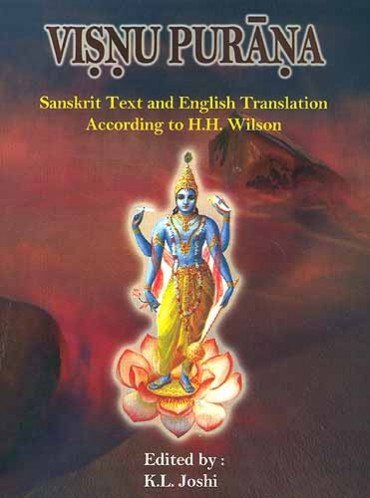The Vishnu Purana
by Horace Hayman Wilson | 1840 | 287,946 words | ISBN-10: 8171102127
The English translation of the Vishnu Purana. This is a primary sacred text of the Vaishnava branch of Hinduism. It is one of the eighteen greater Puranas, a branch of sacred Vedic literature which was first committed to writing during the first millennium of the common era. Like most of the other Puranas, this is a complete narrative from the cr...
Chapter XXII - Future princes of the family of Ikshvaku
I WILL now repeat to you the future princes of the family of Ikṣvāku[1].
The son of Vrihadbala[2] will be Vrihatkṣaṇa[3]; his son will be Urukṣepa[4]; his son will be Vatsa[5]; his son will be Vatsavyūha[6]; his son will be Prativyoman[7]; his son will be Divākara; his son will be Sahadeva[8]; his son will be Vrihadaśva[9]; his son will be Bhānuratha[10]; his son will be Supratītha[11]; his son will be Marudeva[12]; his son will be Sunakṣatra; his son will be Kinnara[13]; his son will be Antarīkṣa; his son will be Suvarna[14]; his son will be Amitrajit[15]; his son will be Vrihadrāja[16]; his son will be Dharman[17]; his son will be Kritañjaya; his son will be Raṇañjaya; his son will be Sañjaya; his son will be Śākya[18]; his son will be Śuddhodana[19]; his son will be Rātula[20]; his son will be Prasenajit; his son will be Kṣudraka; his son will be Kuṇḍaka[21]; his son will be Suratha[22]; his son will be Sumitra. These are the kings of the family of Ikṣvāku, descended from Vrihadbala. This commemorative verse is current concerning them; “The race of the descendants of Ikṣvāku will terminate with Sumitra: it will end in the Kali age with him[23].”
Footnotes and references:
[1]:
See p. 359.
[2]:
Vrihadratha: Vāyu,
[3]:
Vrihatkṣaya: Vāyu. Vrihadraṇa: Bhāg. Omitted: Mats.
[4]:
Omitted: Vāyu. Urukṣaya: Mats. Urukriya: Bhāg.
[5]:
Omitted by all three.
[6]:
Vatsavriddha: Bhāg.
[7]:
Prativyūha: Vāyu.
[8]:
The Bhāgavata inserts Bhānu. The Matsya says that Ayodhyā was the capital of Divākara. The Vāyu omits the next twelve names; probably a defect in the copies.
[9]:
Dhruvāśva: Mats.
[10]:
Bhānumat: Bhāg. Bhāvyaratha or Bhāvya: Mats.
[11]:
Pratikāśva: Bhāg. Pratīpāśva: Mats.
[12]:
The Bhāgavata and Matsya prefix a Supratīpa or Supratīka.
[13]:
Puṣkara: Bhāg.
[14]:
Suparvan or Sumantra: Mats. Sutapas: Bhāg.
[15]:
Amantravit: Matsya.
[16]:
Vrihadbrāja: Bhāg,
[17]:
Omitted: Mats. Varhiṣ: Bhāg.
[18]:
The Bhāgavata and Vāyu have Śākya. My copy of the Matsya has Śādhya, but the Radcliffe MS., more correctly, no doubt, Śakya.
[19]:
In some copies Krodhodana; but it is also Śuddhodana, Mats. and Vāyu; Śuddhoda, Bhāg.
[20]:
Rāhula: Vāyu. Siddhārtha or Puṣkala: Mats. Lāṅgala: Bhāg. This and the two preceding names are of considerable chronological interest; for Śākya is the name of the author or reviver of Buddhism, whose birth appears to have occurred in the seventh, and death in the sixth century before Christ (B. C. 621-543). There can be no doubt of the individual here intended, although he is out of his place, for he was the son, not the father, of Śuddhodana, and the father of Rāhula; as he is termed in the Amara p. 464 and Haima Koṣas, Śaudhodani or Śuddhodana suta the son of Śuddhodana, and Rāhulasū the parent of Rāhula: so also in the Mahāvaṃśo, Siddhārtha or Śākya is the son of Śuddhodano, and father of Rāhulo. Turnour's translation, p. 9. Whether they are rightly included amongst the princes of the race of Ikṣvāku is more questionable; for Śuddhodana is usually described as a petty prince, whose capital was not Ayodhyā, but Kapila or Kapilavastu. At the same time it appears that the provinces of the Doab had passed into the possession of princes of the lunar line, and the children of the sun may have been reduced to the country north of the Ganges, or the modern Gorakhpur, in which Kapila was situated. The Buddhists do usually consider their teacher Śākya to be descended from Ikṣvāku. The chronology is less easily adjusted, but it is not altogether incompatible. According to the lists of the text, Śākya, as the twenty-second of the line of Ikṣvāku, is cotemporary with Ripuñjaya, the twenty-second and last of the kings of Magadhā, of the family of Jarāsandha; but, agreeably to the Buddhist authorities, he was the friend of Bimbasāra, a king who in the Paurāṇik list appears to be the fifth of the Śaiśunāga dynasty, and tenth from Ripuñjaya. The same number of princes does not necessarily imply equal duration of dynasty, and Ikṣvāku's descendants may have outlasted those of Jarāsandha; or, as is more likely—for the dynasty was obscure, and is evidently imperfectly preserved—several descents may have been omitted, the insertion of which would reconcile the Paurāṇik lists with those of the Buddhists, and bring Śākya down to the age of Bimbasāra. It is evident, from what occurs in other authorities, that the Aikṣvākava princes are regarded as cotemporaries even of the Śaiśunāga dynasty: see c. 24. n. 17.
[21]:
Kṣulika: Vāyu. Kulaka or Kṣullaka: Mats. Omitted: Bhāg. In the Mahāvīra Charitra, a work written by the celebrated Hemacandra, in the twelfth century, we have a Prasenajit, king of Magadhā, residing at Rajgriha, succeeded by Śrenīka, and he by Kūlika. The Bauddhas have a Prasenajit cotemporary with Śākya, son of Mahāpadma, king of Magadhā. There is some confusion of persons either in the Paurāṇik genealogies or in the Buddhist and Jain traditions, but they agree in bringing the same names together about the same period.
[22]:
Omitted: Bhāg.
[23]:
The Vāyu and Bhāgavata have the same stanza. We have here twenty-nine or thirty princes of the later solar line, cotemporary with the preceding twenty-six or twenty-seven of the later dynasty of the moon.
